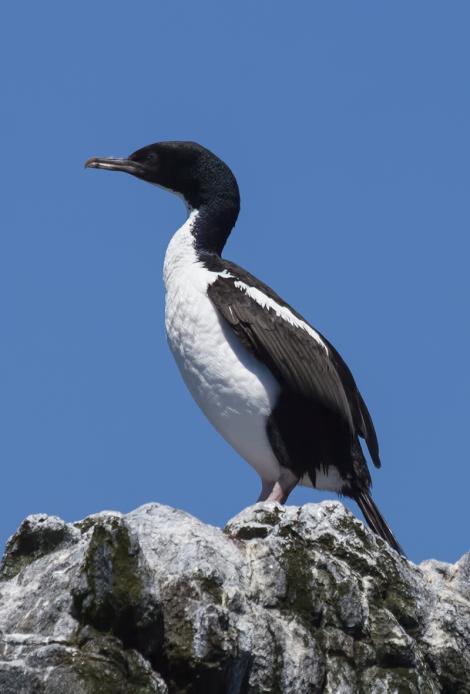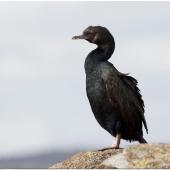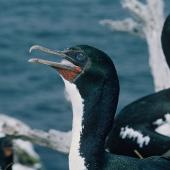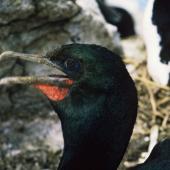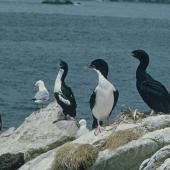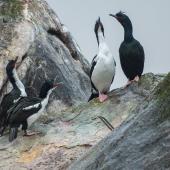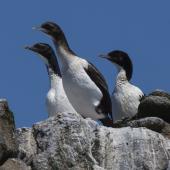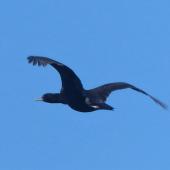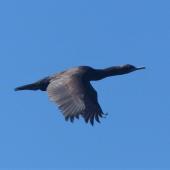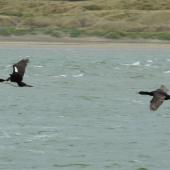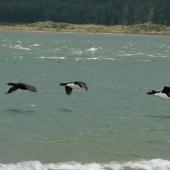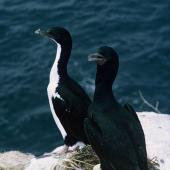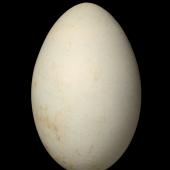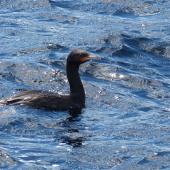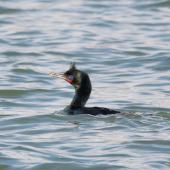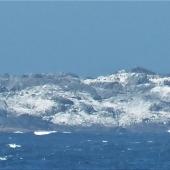Foveaux shag | Mapo
Leucocarbo stewarti (Ogilvie-Grant, 1898)
Order: Suliformes
Family: Phalacrocoracidae
New Zealand status: Endemic
Conservation status: Nationally Vulnerable
Other names: Stewart Island shag, bronze shag, kawau
Geographical variation: Two colour morphs, bronze and pied, which inter-breed
Foveaux shags are large marine shags with variable plumage, found only in southern New Zealand around Foveaux Strait and Rakiura / Stewart Island. The pied morph has striking black-and-white plumage, whilst the bronze form appears brown, but is iridescent in the right lighting conditions. Foveaux shags are seen in ‘line astern’ squadrons heading to and from foraging grounds. The flocking behaviour, heavy build and flight close to the water is diagnostic within its range. The habit of group foraging in murky water places Foveaux shags at risk from set-net entanglement.
Identification
The Foveaux shag is a large pink-footed shag of southern New Zealand around Foveaux Strait and Rakiura Stewart Island. The pied morph (making up 50-60% of the population) has a dark head and white belly and throat, with white patches on the otherwise black wings. These appear as a white bar when the wings are folded. The back feathers are black with a blue sheen, and the tail is black. The bronze morph (making up 40-50% of the population) is entirely brownish-black, with a green sheen on the wings and blue sheen on the body. The bill is pale brown, pink or grey with a dark culmen ridge; the iris is brown. In breeding plumage both morphs have dark orange scattered papillae, and a bright to dark orange gular pouch (facial colouring). Non-breeding birds are similar, but have duller facial skin colour and no crests. Juveniles are also dimorphic (e.g. pied or bronze) but are duller with pale facial skin and no caruncles. Birds of all ages fly with their necks straight.
Voice:
Not reported, but likely to be similar to Otago shag.
Similar species:
Around southern New Zealand, Foveaux shag may be confused with the larger Otago shag. Ways to separate pied and bronze morphs from Otago shag are poorly understood and are the subject of ongoing research at Otago University.
The pied morph of Foveaux shag may be confused with the similarly-sized pied shag, and the bronze morph may be confused with the black shag. Both pied and black shags have black feet and fly with an S-shaped neck. Pied shags have more white on their face, and lack white patches on their upper wings. Pied and black shags are more likely to perch in trees, whereas Foveaux shags do not.
Distribution and habitat
Holocene fossil and archaeological midden assemblages show that at the time of Polynesian arrival in Aotearoa / New Zealand around 1280AD, Foveaux shag was restricted to islands in Foveaux Strait, including Rakiura Stewart Island. While Foveaux shag lost some genetic diversity after human arrival, they have had a stable demographic history and geographic range (cf. Otago shag). Foveaux shags currently occur in southern New Zealand throughout Foveaux Strait (including Te Wae Wae Bay) and around Rakiura / Stewart Island. The eastern range limit is poorly defined and may overlap with Otago shag. It is likely that birds observed west of the Brothers Point are Foveaux shag.
Foveaux shags are birds of coastal waters and harbours. They roost on headlands, small islands and on man-made structures.
Population
Prior to the taxonomic splitting of Otago and Foveaux shag (which were previously recognised as Stewart Island shag), combined estimates varied between 1600-1800 pairs, to fewer than 5000 birds.
Threats and conservation
Foveaux shags are at risk from fishing interactions, particularly entanglement in set-nets, but occasionally by being shot (illegally) by fishers. Other threats include disturbance at breeding colonies. In Foveaux Strait, all successful breeding colonies are either on islands or protected areas.
Breeding
Foveaux shags are colonial nesters in both small and large colonies, on rocky cliffs or bluffs. The pedestal nests are made of seaweed, sticks and grass cemented with guano. Each nest is just out of pecking reach of the next nest. Nest material is often stolen from unguarded nests. Colonies may persist for many years, or be suddenly abandoned. Breeding season may vary between years and colonies. Foveaux shag breeding behaviour and ecology has not been well studied. The 1-3 eggs are laid from September to December. Breeders are probably monogamous, and share incubation. Chicks are mainly fed in the afternoon, and beg for food with a squeaky call from one week old. They breed from three-years-old.
Behaviour and ecology
Foveaux shags may roost in large flocks on headlands or man-made structures. Flocks flying to or from grounds fly in long lines close to the water.
Food
Foveaux shags forage in groups, in water up to 30 m. They are able to successfully forage in murky water. In such conditions the foraging strategy is based on ‘disturb and strike’ rather than ‘see and chase’.
Websites
References
Crossland, A.C. 2012. A review of the current range of Stewart Island shag (Leucocarbo chalconotus) and two records from Lake Ellesmere, Canterbury. Notornis 59: 71-73.
Heather, B.D.; Robertson, H.A. 1996 (rev 2000). The field guide to the birds of New Zealand. Viking, Auckland.
Lalas, C. 1983. Comparative feeding ecology of New Zealand marine shags (Phalacrocoracidae). Ph.D. thesis (Zoology). University of Otago, Dunedin.
Lalas, C.; Perriman, L. 2009. Nest counts of Stewart Island shags/mapua (Leucocarbo chalconotus) in Otago. DOC Research & Development Series 314. 29 p. Department of Conservation, Wellington
Marchant, S.; Higgins, P.J. (eds.). 1990. Handbook of Australian, New Zealand and Antarctic birds. Vol. 1, ratites to ducks. Oxford University Press: Melbourne.
Parker, G.C.; Rexer-Huber, K. 2021. Foveaux and Otago shag population census methods: drone and camera trials. DRAFT final report for BCBC2020-24 for the Department of Conservation. Dunedin, Parker Conservation.
Rawlence, N.J.; Till, C.E.; Scofield, R.P.; Tennyson, A.J.D.; Collins, C.J.; Lalas, C.; Loh, G.; Matisoo-Smith, E.; Waters, J.M.; Spencer, H.G.; Kennedy, M. 2014. Strong phylogeographic structure in a sedentary seabird, the Stewart Island shag (Leucocarbo chalconotus). PLoS One 9: e90769.
Rawlence, N.J.; Kennedy, M.; Anderson, C.N.K.; Prost, S.; Till, C.E.; Smith, I.W.G.; Scofield, R.P.; Tennyson, A.J.D.; Hamel, J.; Lalas, C.; Matisoo-Smith, E.A.; Waters, J.M. 2015. Geographically contrasting biodiversity reductions in a widespread New Zealand seabird. Molecular Ecology 24: 4605-4616.
Rawlence, N.J.; Scofield, R.P.; Spencer, H.G; Lalas, C.; Easton, L.J.; Tennyson, A.J.D.; Adams, M.; Pasquet, E.; Fraser, C.; Waters, J.M.; Kennedy, M. 2016. Genetic and morphological evidence for two species of Leucocarbo shag (Aves, Pelecaniformes, Phalacrocoracidae) from southern South Island of New Zealand. Zoological Journal of the Linnean Society 177: 676-694.
Rawlence, N.J.; Salis, A.T.; Spencer, H.G.; Waters, J.M.; Scarsbrook, L.; Mitchell, K.J.; Phillips, R.A.; Calderon, L.; Cook, T.R.; Bost, C-A.; Dutoit, L.; Masello, J.F.; Nupen, L.J.; Quillfeldt, P.; Ratcliffe, N.; Ryan, P.G.; Till, C.E.; Kennedy, M. 2022. Rapid radiation of Southern Ocean shags in response to receding sea ice. Journal of Biogeography 49: 942-953.
Robertson, C.J.R.; Hyvönen, P.; Fraser, M.J.; Pickard, C.R. 2006. Atlas of bird distribution in New Zealand 1999-2006. Ornithological Society of New Zealand, Wellington.
Robertson, H.A; Baird, K.; Elliott, G.P.; Hitchmough, R.A.; McArthur, N.J.; Makan, T.; Miskelly, C.M.; O’Donnell, C.F.J.; Sagar, P.M.; Scofield, R.P.; Taylor, G.A.; Michel, P. 2021. Conservation status of birds in Aotearoa New Zealand birds, 2021. New Zealand Threat Classification Series 36. Wellington, Department of Conservation. 43p.
Recommended citation
McKinlay, B.; Rawlence, N.J. 2022. Foveaux shag. In Miskelly, C.M. (ed.) New Zealand Birds Online. www.nzbirdsonline.org.nz
Foveaux shag | Mapo
- Social structure
- monogamous
- Breeding season
-
- Jul
- Aug
- Sep
- Oct
- Nov
- Dec
- Jan
- Feb
- Mar
- Apr
- May
- Jun
- Nest type
- mud nest
- Nest description
- Nests are of a top hat design, where vegetation is gathered and incorporated into the nest and cemented by faeces. The nest builds up over the season, about 0.5m wide.
- Nest height (mean)
- 0.3 m
- Nest height (min)
- 0 m
- Nest height (max)
- 1 m
- Clutch size (mean)
- 2
- Clutch size (min)
- 1
- Clutch size (max)
- 3
- Mean egg dimensions (length)
- 66 mm
- Mean egg dimensions (width)
- 42 mm
- Egg colour
- pale blue
- Egg laying dates
-
- Jul
- Aug
- Sep
- Oct
- Nov
- Dec
- Jan
- Feb
- Mar
- Apr
- May
- Jun
- Incubation behaviour
- shared
- Nestling type
- altricial




